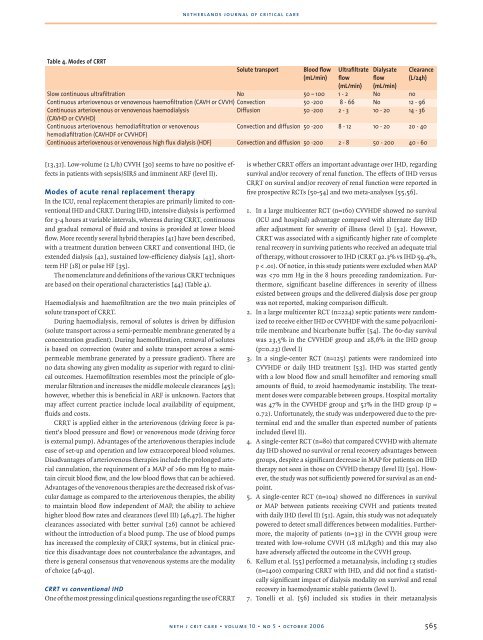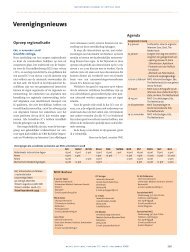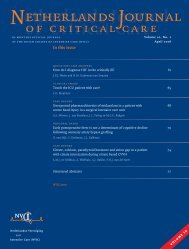Netherlands Journal
NJCC Volume 10, Oktober 2006
NJCC Volume 10, Oktober 2006
- No tags were found...
You also want an ePaper? Increase the reach of your titles
YUMPU automatically turns print PDFs into web optimized ePapers that Google loves.
netherlands journal of critical care<br />
Table 4. Modes of CRRT<br />
Solute transport<br />
Blood flow<br />
(mL/min)<br />
Ultrafiltrate<br />
flow<br />
(mL/min)<br />
Dialysate<br />
flow<br />
(mL/min)<br />
Clearance<br />
(L/24h)<br />
Slow continuous ultrafiltration No 50 – 100 1 - 2 No no<br />
Continuous arteriovenous or venovenous haemofiltration (CAVH or CVVH) Convection 50 -200 8 - 66 No 12 - 96<br />
Continuous arteriovenous or venovenous haemodialysis<br />
Diffusion 50 -200 2 - 3 10 - 20 14 - 36<br />
(CAVHD or CVVHD)<br />
Continuous arteriovenous hemodiafiltration or venovenous<br />
Convection and diffusion 50 -200 8 - 12 10 - 20 20 - 40<br />
hemodiafiltration (CAVHDF or CVVHDF)<br />
Continuous arteriovenous or venovenous high flux dialysis (HDF) Convection and diffusion 50 -200 2 - 8 50 - 200 40 - 60<br />
[13,31]. Low-volume (2 L/h) CVVH [30] seems to have no positive effects<br />
in patients with sepsis/SIRS and imminent ARF (level II).<br />
Modes of acute renal replacement therapy<br />
In the ICU, renal replacement therapies are primarily limited to conventional<br />
IHD and CRRT. During IHD, intensive dialysis is performed<br />
for 3-4 hours at variable intervals, whereas during CRRT, continuous<br />
and gradual removal of fluid and toxins is provided at lower blood<br />
flow. More recently several hybrid therapies [41] have been described,<br />
with a treatment duration between CRRT and conventional IHD, (ie<br />
extended dialysis [42], sustained low-efficiency dialysis [43], shortterm<br />
HF [18] or pulse HF [35].<br />
The nomenclature and definitions of the various CRRT techniques<br />
are based on their operational characteristics [44] (Table 4).<br />
Haemodialysis and haemofiltration are the two main principles of<br />
solute transport of CRRT.<br />
During haemodialysis, removal of solutes is driven by diffusion<br />
(solute transport across a semi-permeable membrane generated by a<br />
concentration gradient). During haemofiltration, removal of solutes<br />
is based on convection (water and solute transport across a semipermeable<br />
membrane generated by a pressure gradient). There are<br />
no data showing any given modality as superior with regard to clinical<br />
outcomes. Haemofiltration resembles most the principle of glomerular<br />
filtration and increases the middle molecule clearances [45];<br />
however, whether this is beneficial in ARF is unknown. Factors that<br />
may affect current practice include local availability of equipment,<br />
fluids and costs.<br />
CRRT is applied either in the arteriovenous (driving force is patient’s<br />
blood pressure and flow) or venovenous mode (driving force<br />
is external pump). Advantages of the arteriovenous therapies include<br />
ease of set-up and operation and low extracorporeal blood volumes.<br />
Disadvantages of arteriovenous therapies include the prolonged arterial<br />
cannulation, the requirement of a MAP of >60 mm Hg to maintain<br />
circuit blood flow, and the low blood flows that can be achieved.<br />
Advantages of the venovenous therapies are the decreased risk of vascular<br />
damage as compared to the arteriovenous therapies, the ability<br />
to maintain blood flow independent of MAP, the ability to achieve<br />
higher blood flow rates and clearances (level III) [46,47]. The higher<br />
clearances associated with better survival [26] cannot be achieved<br />
without the introduction of a blood pump. The use of blood pumps<br />
has increased the complexity of CRRT systems, but in clinical practice<br />
this disadvantage does not counterbalance the advantages, and<br />
there is general consensus that venovenous systems are the modality<br />
of choice [46-49].<br />
CRRT vs conventional IHD<br />
One of the most pressing clinical questions regarding the use of CRRT<br />
is whether CRRT offers an important advantage over IHD, regarding<br />
survival and/or recovery of renal function. The effects of IHD versus<br />
CRRT on survival and/or recovery of renal function were reported in<br />
five prospective RCTs [50-54] and two meta-analyses [55,56].<br />
1. In a large multicenter RCT (n=160) CVVHDF showed no survival<br />
(ICU and hospital) advantage compared with alternate day IHD<br />
after adjustment for severity of illness (level I) [52]. However,<br />
CRRT was associated with a significantly higher rate of complete<br />
renal recovery in surviving patients who received an adequate trial<br />
of therapy, without crossover to IHD (CRRT 92.3% vs IHD 59.4%,<br />
p < .01). Of notice, in this study patients were excluded when MAP<br />
was







